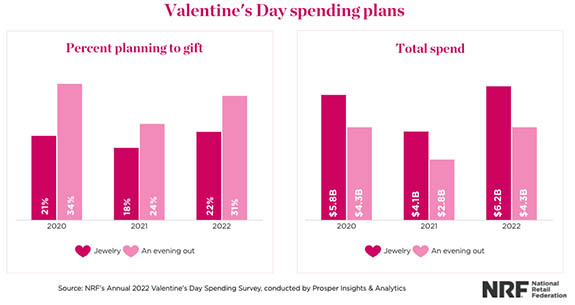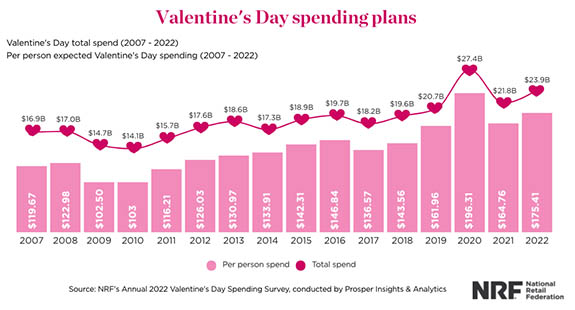February 8th, 2022
Americans are set to spend a record $6.2 billion on jewelry gifts for Valentine's Day, an amazing increase of 51.2% compared to 2021 and the highest tally ever, according to a survey just released by the National Retail Federation (NRF) and Prosper Insights & Analytics.

The NRF stats reveal that Valentine shoppers will be spending more on jewelry than any other type of gift. Jewelry will account for more than a quarter of all Valentine’s Day spending, which is estimated to reach $23.9 billion this year. The jewelry category's 25.9% chunk of the spending pie is far higher than it was in 2021, when it accounted for 18.8%.

“Following the historic level of consumer spending over the winter holidays, it appears that the trend will continue into 2022,” NRF President and CEO Matthew Shay said. “Valentine’s Day is a special occasion for many Americans, even more so as we navigate out of the pandemic, and retailers are prepared to help them mark the holiday in a memorable and meaningful way.”
More than half (53%) of US consumers plan to celebrate Valentine's Day in 2022, up from 52% in 2021. More than three-quarters (76%) of those celebrating indicate it is important to do so given the current state of the pandemic.

According to the survey, shoppers expect to spend an average of $175.41 per person on Valentine’s Day gifts, up from $164.76 in 2021.
Nearly a quarter (22%) of respondents said they will gift a jewelry item to a special someone, while nearly a third (31%) of respondents plan to gift an “evening out” this year, up from 24% in 2021 and just slightly below pre-pandemic levels, for a total of $4.3 billion.
Other popular, but less expensive, Valentine gifts include candy (to be given by 56%), greeting cards (40%) and flowers (37%). Demand for "gifts of experience," such as tickets to a concert or sporting event, has also returned to pre-pandemic levels, with 41% saying they would “love to receive a gift of experience,” up from 36% last year.
The survey of 7,728 U.S. adult consumers was conducted Jan. 3-11 and has a margin of error of plus or minus 1.1 percentage points.
Credits: Image by BigStockPhoto.com. Charts courtesy of the National Retail Federation.

The NRF stats reveal that Valentine shoppers will be spending more on jewelry than any other type of gift. Jewelry will account for more than a quarter of all Valentine’s Day spending, which is estimated to reach $23.9 billion this year. The jewelry category's 25.9% chunk of the spending pie is far higher than it was in 2021, when it accounted for 18.8%.

“Following the historic level of consumer spending over the winter holidays, it appears that the trend will continue into 2022,” NRF President and CEO Matthew Shay said. “Valentine’s Day is a special occasion for many Americans, even more so as we navigate out of the pandemic, and retailers are prepared to help them mark the holiday in a memorable and meaningful way.”
More than half (53%) of US consumers plan to celebrate Valentine's Day in 2022, up from 52% in 2021. More than three-quarters (76%) of those celebrating indicate it is important to do so given the current state of the pandemic.

According to the survey, shoppers expect to spend an average of $175.41 per person on Valentine’s Day gifts, up from $164.76 in 2021.
Nearly a quarter (22%) of respondents said they will gift a jewelry item to a special someone, while nearly a third (31%) of respondents plan to gift an “evening out” this year, up from 24% in 2021 and just slightly below pre-pandemic levels, for a total of $4.3 billion.
Other popular, but less expensive, Valentine gifts include candy (to be given by 56%), greeting cards (40%) and flowers (37%). Demand for "gifts of experience," such as tickets to a concert or sporting event, has also returned to pre-pandemic levels, with 41% saying they would “love to receive a gift of experience,” up from 36% last year.
The survey of 7,728 U.S. adult consumers was conducted Jan. 3-11 and has a margin of error of plus or minus 1.1 percentage points.
Credits: Image by BigStockPhoto.com. Charts courtesy of the National Retail Federation.


